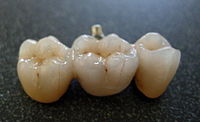
Photo from wikipedia
The aim of this study is to assess the effect of different bleaching agents on microhardness and color of CAD/CAM ceramics including IPS e.max CAD (lithium disilicate), VITA ENAMIC (polymer-infiltrated… Click to show full abstract
The aim of this study is to assess the effect of different bleaching agents on microhardness and color of CAD/CAM ceramics including IPS e.max CAD (lithium disilicate), VITA ENAMIC (polymer-infiltrated ceramic), and Celtra Duo CAD (zirconia-reinforced lithium silicate). Materials’ samples were divided into three groups (n = 10) and each received a different bleaching treatment; 20% carbamide peroxide, 35% carbamide peroxide, and 40% hydrogen peroxide. A fourth group was stored in water acting as a control. Vickers microhardness and spectrophotometric color measurements were taken at baseline and after bleaching. IPS e.max CAD showed a significant reduction (about 14%), while VITA ENAMIC showed a significant increase (about 78%) in microhardness after bleaching (p ˂ 0.001). Celtra Duo CAD did not demonstrate a significant change in microhardness (p ≥ 0.609). The color difference (ΔEab) after bleaching was 0.29 (±0.08), 2.84 (±0.64), and 1.99 (±0.37) for IPS e.max CAD, VITA ENAMIC, and Celtra Duo CAD, respectively. It could be concluded that the effect of bleaching on color and microhardness was mainly material-dependent. Bleaching significantly affected the microhardness of IPS e.max CAD and VITA ENAMIC. The color difference was within the clinically imperceptible range for IPS e.max CAD, while VITA ENAMIC and Celtra Duo CAD demonstrated perceptible color change.
Journal Title: Materials
Year Published: 2022
Link to full text (if available)
Share on Social Media: Sign Up to like & get
recommendations!